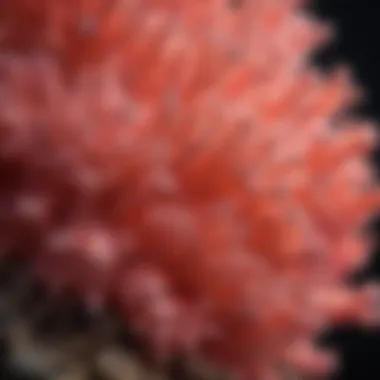Explore the Extravagant World of Rare Coral Specimens: A Collector's Guide


Rock and Fossil Identification
Expensive coral for sale entices collectors with its diversity and uniqueness. It is crucial for collectors to familiarize themselves with the types of coral available in the market. From the vibrant Acropora to the delicate Goniopora, each species boasts distinct characteristics that set them apart. Observing the shapes, colors, and textures is essential in identifying these precious specimens. Utilizing tools like magnifying glasses and specialized coral identification guides can aid enthusiasts in distinguishing between different varieties.
Collecting Tips and Techniques
Aspiring coral collectors must adhere to best practices when sourcing these valuable specimens. Locating prime collecting sites often involves extensive research and networking within the coral community. Furthermore, understanding how to ethically and sustainably extract coral specimens from their natural habitats is paramount. Techniques such as fragging, a process that involves dividing corals to grow new colonies, can aid in preserving coral populations while satisfying collectors' desires.
Preservation and Display
Preserving expensive coral requires meticulous care and attention to detail. Adopting techniques like coral fragging not only aids in expanding coral colonies but also acts as a preservation method. Proper storage methods, such as maintaining stable water parameters in aquariums, contribute to the longevity of collected specimens. Additionally, creative display ideas like aquascaping, where corals are artistically arranged in aesthetically pleasing underwater landscapes, enhance the visual appeal of coral collections.
Geological Insights
While coral may not be classified as rocks or fossils, they hold significant geological importance. Understanding the geological formation processes that contribute to coral reef growth is essential for collectors. The historical significance of coral reefs in marine ecosystems and their vulnerability to environmental threats underscores the importance of conservation efforts. Exploring notable discoveries in the field, such as new coral species or unique coral formations, adds a layer of excitement to the collecting experience.
Introduction
In the vast world of collectors' items, expensive coral stands out as a unique and captivating treasure sought after by enthusiasts and experts alike. This article serves as a beacon, guiding readers through the intricate realm of expensive coral for sale, shedding light on its allure and intricacies. As we embark on this journey together, we will unravel the mysteries surrounding these prized specimens, exploring the depths of rare varieties, ethical considerations, and expert insights that underpin the world of expensive coral.
Expensive coral exudes a mystique that transcends mere monetary value; it symbolizes a profound connection to the ocean's wonders. Through this guide, we aim to unveil the layers of significance embedded within these coral specimens, opening a window into a realm where rarity meets beauty and ethical responsibility.
An essential element of this article is to demystify the process of acquiring expensive coral, offering readers a roadmap to navigate the complexities of the market. By delving into various aspects such as authentication procedures, top places for acquisition, and maintenance practices, we empower enthusiasts to make well-informed decisions and cherish these treasures responsibly. This introduction sets the stage for an enriching exploration of expensive coral, setting the tone for a comprehensive guide that transcends mere transactional values to embrace the essence of these natural marvels.
Understanding Expensive Coral


Defining Expensive Coral
In exploring the concept of 'Defining Expensive Coral,' it is essential to outline the criteria that categorize coral as valuable. Factors such as species rarity, color vibrancy, size, and overall condition play a significant role in determining the worth of a coral piece. Additionally, the origin of the coral, including where it was harvested and its journey to the market, factors into its value. By defining what makes coral 'expensive,' collectors can better navigate the market, discerning between truly high-value specimens and those that may not hold the same allure.
Rare Varieties of Coral
The section on 'Rare Varieties of Coral' delves into the diverse spectrum of exotic coral types that captivate collectors worldwide. From elusive black corals to intricately patterned brain corals, each rare variety boasts its own unique appeal and scarcity. By shedding light on these exceptional specimens, enthusiasts can expand their knowledge of the vast coral kingdom and appreciate the beauty and complexity that rare coral varieties offer. Furthermore, understanding these rare types equips collectors with the expertise to spot valuable pieces and add coveted specimens to their collections.
Factors Influencing Coral Prices
Examining the 'Factors Influencing Coral Prices' provides valuable insight into the dynamic forces that dictate the market value of these prized marine treasures. Various elements contribute to the pricing of expensive coral, including rarity, demand, condition, and market trends. By delving into these influencing factors, collectors can gain a deeper appreciation for the intricate pricing mechanisms at play in the coral industry. Additionally, understanding these pricing determinants empowers enthusiasts to make informed investment decisions and discern the true value of high-end coral specimens.
Market Trends in Coral Sales
The section on 'Market Trends in Coral Sales' explores the ever-evolving landscape of coral commerce, showcasing the shifts and patterns evident in the buying and selling of expensive coral. By analyzing market trends, including fluctuations in demand, emerging consumer preferences, and global influences, collectors can stay abreast of the latest developments in the coral market. Understanding these trends not only offers valuable insights into the future trajectory of coral sales but also enables enthusiasts to make strategic decisions when acquiring or selling high-value coral pieces.
Ethical Considerations
Ethical considerations play a pivotal role in the realm of expensive coral collection, acting as the moral compass that guides collectors and enthusiasts towards responsible actions. In this article, the discussion on ethical considerations delves into crucial aspects that shape the ethical landscape of coral acquisition and ownership. By highlighting the importance of sustainability, legality, and conservation in coral collection, readers gain a profound understanding of the significance of ethical practices in maintaining ecological balance and protecting these precious marine resources.
Sustainability Practices
Eco-Friendly Harvesting Methods
Eco-friendly harvesting methods represent a cornerstone of ethical coral collection practices. These methods prioritize the preservation and regeneration of coral reefs by employing non-invasive techniques that minimize environmental impact. The key characteristic of eco-friendly harvesting lies in its minimal disruption to coral habitats, ensuring the long-term health and sustainability of marine ecosystems. This environmentally conscious approach benefits both coral populations and marine biodiversity, making it a cornerstone choice for ethical collectors aiming to protect and nurture coral reefs. A unique feature of eco-friendly harvesting is its focus on sustainable harvesting practices that promote coral reef resilience while mitigating the risks of overexploitation and habitat degradation.
Conservation Efforts


The commitment to conservation efforts underscores the ethical responsibility of coral collectors to safeguard endangered species and fragile marine environments. Conservation efforts involve initiatives aimed at protecting coral reefs, restoring damaged habitats, and advocating for sustainable resource management. The key characteristic of conservation efforts lies in their dedication to preserving biodiversity and combating the threats facing coral ecosystems. By supporting conservation projects and initiatives, collectors contribute to the long-term survival of coral species and the health of surrounding marine ecosystems. A unique feature of conservation efforts is their collaborative nature, which brings together stakeholders from various sectors to address the complex challenges of coral reef conservation.
Legal Regulations
In the complex landscape of coral collection, legal regulations serve as essential frameworks that govern the trade, possession, and transportation of expensive coral specimens. These regulations are designed to ensure compliance with international conventions, local laws, and protection measures that aim to prevent illegal harvesting and trafficking of endangered coral species. By adhering to legal requirements, collectors play a key role in combating illicit trade practices and safeguarding the sustainability of coral ecosystems. Legal regulations provide a necessary foundation for responsible coral collection, promoting transparency, accountability, and adherence to ethical standards within the industry.
Acquiring Expensive Coral
In the expansive world of expensive coral, the process of acquiring these precious specimens carries immense significance. This section delves into the meticulous journey collectors embark upon to add these rare beauties to their collections. When it comes to acquiring expensive coral, attention to detail is paramount. Each piece is unique, with its own story to tell, making the selection process a crucial aspect for collectors. Understanding the authenticity and quality of the coral being acquired is essential to ensure a valuable addition to one's collection.
Exploring the market for expensive coral can be a daunting task, where knowledge about authentication and certification plays a vital role. Authentication confirms the origin and quality of the coral, protecting buyers from misrepresented or counterfeit products. Certification adds another layer of assurance, providing documented evidence of the coral's authenticity and ethical sourcing. These steps not only validate the integrity of the coral but also contribute to promoting sustainable practices within the industry.
Considering the ethical implications of purchasing expensive coral is imperative for conscious collectors. While some may prioritize the aesthetics of the specimens, others focus on supporting eco-friendly harvesting methods and conservation efforts. It's essential to align personal values with the sources from which coral is acquired to ensure a positive impact on marine ecosystems. By choosing suppliers who adhere to legal regulations and sustainable practices, collectors can contribute to the preservation of coral reefs worldwide.
Authentication and Certification
In the realm of acquiring expensive coral, authentication and certification serve as pillars of trust and credibility for collectors. The process of authentication involves verifying the authenticity and quality of coral specimens, safeguarding buyers against inaccuracies and fraudulent products. Through thorough examination by experts or accredited institutions, the origin, species, and age of the coral can be confirmed, ensuring that collectors receive genuine and valuable pieces.
Certification complements authentication by providing official documentation that validates the ethical and legal compliance of the coral being purchased. This certification not only attests to the provenance and characteristics of the coral but also ensures that it has been responsibly harvested and traded. By seeking certified coral products, collectors contribute to the promotion of sustainable practices and ethical standards in the coral trade industry, fostering a culture of transparency and accountability.
Top Places to Purchase Coral
When it comes to acquiring expensive coral, selecting the right source is crucial for ensuring a satisfactory purchase experience. Various avenues exist for collectors to explore, from specialized coral boutiques to online marketplaces and auctions. Engaging with reputable dealers and retailers known for their expertise and credibility can provide access to a diverse range of high-quality coral specimens.
Specialized marine aquarium stores offer a curated selection of coral varieties, catering to the needs of both amateur and experienced collectors. These establishments often provide personalized advice and care recommendations, enabling collectors to make informed decisions based on their preferences and expertise. Online platforms dedicated to coral sales can also be valuable sources for acquiring unique and rare specimens, offering convenience and accessibility to a global market of coral enthusiasts.


Caring for Expensive Coral
Caring for Expensive Coral is a crucial aspect of this article as it ensures the longevity and vibrancy of these prized specimens. Proper care not only maintains the aesthetic appeal of the coral but also contributes to their overall health and sustainability. Enthusiasts and collectors need to understand the specific elements involved in caring for expensive coral to uphold their value and beauty.
Maintenance Tips
Proper Cleaning Techniques
Proper Cleaning Techniques play a pivotal role in preserving the quality of expensive coral. By employing gentle cleaning methods and suitable solutions, collectors can remove unwanted build-up without damaging the delicate coral structures. The key characteristic of Proper Cleaning Techniques lies in their ability to effectively cleanse the coral while preventing harm. This approach is favored for its gentle yet thorough cleaning process, ensuring that the coral remains unblemished. Proper Cleaning Techniques boast a unique feature of being non-invasive, safeguarding the coral's integrity without causing any harm. In this article, Proper Cleaning Techniques offer the advantage of maintaining the coral's pristine condition without compromising its value.
Environmental Conditions
Environmental Conditions are vital considerations when caring for expensive coral. Maintaining optimal environmental parameters such as water quality, temperature, and lighting is essential for the well-being of coral specimens. The key characteristic of Environmental Conditions lies in their ability to create a suitable habitat that mimics the coral's natural environment. This choice is beneficial as it replicates the conditions necessary for healthy coral growth and development. Environmental Conditions exhibit a unique feature of promoting coral resilience and vitality, ensuring their long-term health and vibrancy. In this article, prioritizing proper Environmental Conditions offers the advantage of fostering a thriving coral ecosystem, enhancing the beauty and sustainability of these exquisite specimens.
Display and Arrangement
Display and Arrangement play a significant role in showcasing expensive coral while enhancing their visual appeal. How collectors choose to present their coral specimens can greatly impact the overall aesthetic and appreciation of these treasures. Finding the perfect balance between showcasing the coral's beauty and ensuring its well-being is essential for creating an engaging display. Proper arrangement can complement the colors and shapes of different coral varieties, creating a visually appealing exhibit that highlights their uniqueness and beauty. By arranging coral specimens thoughtfully, collectors can create a harmonious display that showcases the diversity and intricacies of these precious creations.
Conclusion
In the realm of expensive coral aquariums, the conclusion serves as a vital component in tying together the key points discussed throughout this comprehensive collector's guide. As enthusiasts delve into the intricacies of acquiring and caring for these prized coral specimens, a well-rounded conclusion acts as a compass, guiding them towards a deeper understanding of the fine details that encompass the world of collecting expensive corals.
One of the primary emphases of this conclusion is the significance of ethical considerations in the world of expensive coral acquisition. By highlighting the importance of sustainable practices and legal regulations surrounding coral harvesting and trade, collectors are urged towards responsible stewardship of these valuable marine resources.
Furthermore, the conclusion sheds light on the interconnectedness between market trends and coral prices, providing insights into how various factors influence the value and availability of rare coral varieties. This section serves as a final elucidation on the dynamic nature of the coral market, equipping collectors with essential knowledge to make informed decisions in their acquisition endeavors.
Ultimately, this conclusion aims to encapsulate the essence of the collector's guide, emphasizing the multifaceted aspects that define the world of expensive coral. By synthesizing the information presented throughout the article, enthusiasts are empowered to navigate the intricacies of acquiring, caring, and showcasing these exquisite marine treasures, ensuring a fulfilling and sustainable pursuit for all coral collectors.
Further Reading
In the realm of expensive coral collecting, delving deeper into the subject through additional resources is crucial for enthusiasts looking to expand their knowledge and expertise. Further reading plays a vital role in enriching one's understanding of the intricacies surrounding expensive coral varieties, market dynamics, and conservation efforts. By engaging with authoritative publications, academic articles, and industry insights, collectors can stay informed about the latest trends, developments, and ethical considerations shaping the world of high-end coral trade.
Furthermore, exploring diverse perspectives and research findings in the realm of expensive coral can offer valuable insights into sustainability practices, legal frameworks, and authentication techniques. As the market for rare coral continues to evolve, staying updated through comprehensive reading materials equips collectors with the necessary information to make informed decisions and foster a deeper appreciation for these exquisite marine specimens. Embracing further reading not only enhances one's expertise in coral acquisition and care but also contributes to the ongoing dialogue surrounding ethical sourcing and conservation initiatives in the industry.







